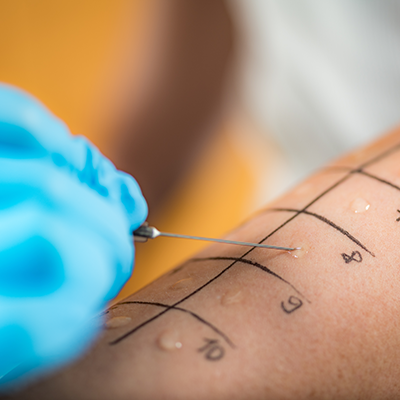Skin Prick Allergy Tests
A paediatric skin prick allergy test is a common method used to identify allergic sensitivities in children.
Skin prick testing is a safe, quick and widely used method for identifying allergic sensitivities in children. It can help determine whether your child’s symptoms (such as coughing, wheezing, nasal congestion, eczema, or food reactions) are linked to specific allergens such as pollen, dust mites, animals, or certain foods.
What Is a Skin Prick Test?
A skin prick test involves placing a small drop of an allergen on your child’s skin (usually on the forearm or back) followed by a gentle scratch using a sterile lancet. This allows the immune cells just under the skin to come into contact with the substance.
If your child is sensitised to the allergen, the immune system may trigger the release of histamine, causing a small, raised, itchy bump (called a wheal) surrounded by redness (flare). This reaction typically appears within 20 minutes and is measured to help interpret the result.

What Can We Test For?
Skin prick testing can assess sensitisation to a range of allergens, including:
- Environmental allergens
- House dust mites
- Grass and tree pollen
- Animal dander (e.g. cats, dogs)
- Moulds
- Food allergens (if clinically appropriate)
- Cow’s milk
- Egg
- Peanut, tree nuts
- Fish and shellfish
Your child’s test will be tailored based on their history and symptoms. Blanket testing for multiple allergens is not routinely recommended.
How Do Skin Prick Tests Work?

When a small amount of allergen is introduced into the top layer of the skin using a gentle scratch, it allows the immune system to come into contact with the substance.
If your child’s immune system recognises the substance as an allergen, it triggers the release of histamine from specialised immune cells called mast cells in the skin. This causes a small, raised bump (wheal) and surrounding redness (flare) at the test site.
The size of this reaction can be measured and helps guide interpretation. A positive reaction suggests sensitisation to the allergen but does not always mean your child has a clinical allergy.
Do Skin Prick Tests Have Any Side Effects?
Skin prick testing is generally very safe. Occasionally, mild local reactions such as redness or itching may occur, but these usually settle within a few hours.
In extremely rare cases – estimated at around 1 in 10,000 tests – a more significant allergic reaction can occur.
Side effects are more likely if a child is unwell at the time of testing. For this reason, skin prick tests should only be performed in a clinical setting with trained staff and appropriate emergency equipment available. Testing should be postponed if your child is unwell.
Preparing for the Test
Do not give your child antihistamines for at least 7 days before the test, as these can interfere with results.
Let the clinic know if your child is unwell or has had recent asthma symptoms
Will My Child Need a Skin Prick Test?
A consultation is required to assess your child’s history, symptoms, and the likely role of allergy. Your clinician will advise whether testing is appropriate and which allergens to include.
Helpful Video for Children
Children may find this excellent short clip from CBeebies’ Get Well Soon a helpful explainer so they know what to expect during a skin prick test. It’s a reassuring, age-appropriate introduction to the process.
Post-Test Care
If there was a reaction, your child might experience some itching or mild redness at the test sites. This usually resolves quickly. You may be given instructions on caring for the skin, like avoiding scratching or applying topical creams.
Emotional Support
Reassure your child and provide comfort after the test, especially if they were anxious. Celebrating their bravery can also help them feel positive about future medical appointments.
Located in London | Infants to young adults seen
Request a referral or book an appointment with Professor Gupta today.
